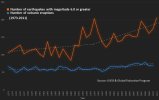lostinself said:no-man's-land said:The recent post from Navigator here:
http://cassiopaea.org/forum/index.php/topic,33168.msg457036.html#msg457036
which shows two graphs of volcanic and seismic activities, and the next one from lostinself here:
http://cassiopaea.org/forum/index.php/topic,33168.msg457573.html#msg457573
which shows another graph also about volcanic activities seemingly contradict each other. In the first link the author Michael Mandeville claims that his Data is also from the Smithsonian Institute catalog. So two sets of data from one source showing two different graphs?
The answer might be that Michael Mandeville displays the "combined days of eruptive episodes" while the Smithsonian database displayed by lostinself only count the numbers of active volcano's and don't show how long the activities lasted. I don't know where Mandeville got this data from but at the Smithsonian database there is no such data, or at least they show only the date when it started, not when the volcano went silent again.
You're probably right on why these graphs don't agree. Wish i had paid more attention to the former plot. I didn't take durations into account at all, and, as you point out, there's no relevant data available at the SI site at the moment. Durations would make a critical difference here, for even a relatively calm event, like a release of ashes, can last continuously for weeks (still representing a volcanic activity). In terms of total volcanic activity on the Planet, i guess Mandeville's plots are more accurate.
I compiled the data from USGS (number of Earthquake with 6.0 or greater - orange curve) and the data from the Global Volcanism Program (number of volcanic eruptions - blue curve) between 1973 and 2011

From 1973 to 1996, earthquake and eruption frequencies were almost stable, increasing only slightly year after year. After 1996 an acceleration is noticeable. Volcanic eruptions show an increase from about 59 eruptions a year at the end of the ’90s to roughly 75 eruptions a year in the 2007–2010 period (+30%).



